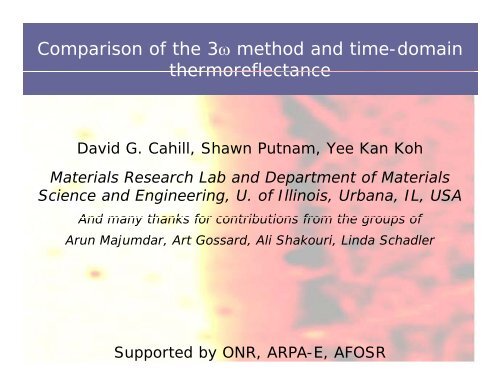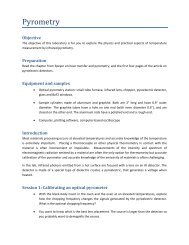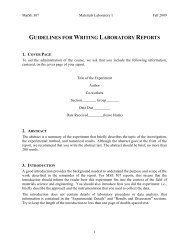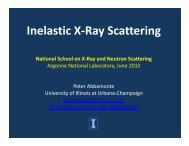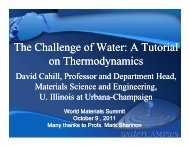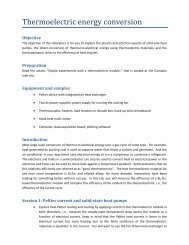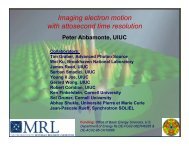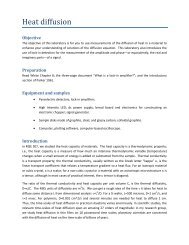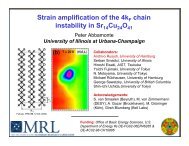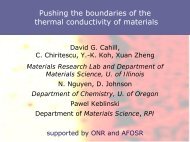Comparison of the 3ω method and time-domain thermoreflectance
Comparison of the 3ω method and time-domain thermoreflectance
Comparison of the 3ω method and time-domain thermoreflectance
- No tags were found...
Create successful ePaper yourself
Turn your PDF publications into a flip-book with our unique Google optimized e-Paper software.
Time-<strong>domain</strong> <strong>the</strong>rmoreflectance
psec acoustics <strong>and</strong><strong>time</strong>-<strong>domain</strong> <strong>the</strong>rmoreflectance• Optical constants <strong>and</strong>reflectivity depend onstrain <strong>and</strong> temperature• Strain echoes giveacoustic properties orfilm thickness• Thermoreflectance gives<strong>the</strong>rmal properties
Schmidt et al., RSI 2008• Heat supplied bymodulated pumppbeam (fundamentalFourier componentat frequency f)• Evolution <strong>of</strong> surfacetemperature<strong>time</strong>
Schmidt et al., RSI 2008• Instantaneoustemperatures measuredby <strong>time</strong>-delayed probe• Probe signal asmeasured by rf lock-inamplifier
Analytical solution to 3D heat flowin an infinite half-space, Cahill, RSI (2004)• spherical <strong>the</strong>rmal wave• Hankel transform <strong>of</strong>surface temperature• Multiply by transform<strong>of</strong> Gaussian heatsource <strong>and</strong> takeinverse transform• Gaussian-weightedsurface temperature8
Iterative solution for layered geometries
Frequency <strong>domain</strong> solution for <strong>3ω</strong> <strong>and</strong>TDTR are essentially <strong>the</strong> same<strong>3ω</strong>• “rectangular” heatsource <strong>and</strong> temperatureaveraging.• One-dimensional Fouriertransform.• “known” quantities in<strong>the</strong> analysis are Jouleheating <strong>and</strong> dR/dTcalibration.TDTR• Gaussian heat source<strong>and</strong> temperatureaveraging.• Radial symmetric Hankeltransform.• “known” quantity in <strong>the</strong>analysis is <strong>the</strong> heatcapacity per unit area <strong>of</strong><strong>the</strong> metal filmtransducer.
TDTR signal analysis for <strong>the</strong> lock-insignal as a function <strong>of</strong> delay <strong>time</strong> t• In-phase <strong>and</strong> out-<strong>of</strong>-phase signals by series <strong>of</strong> sum <strong>and</strong>difference over sideb<strong>and</strong>s• out-<strong>of</strong>-phase signal is dominated by <strong>the</strong> m=0 term• out <strong>of</strong> phase signal is dominated by <strong>the</strong> m=0 term(frequency response at modulation frequency f)
Windows s<strong>of</strong>twareauthor: Catalin Chiritescu,users.mrl.uiuc.edu/cahill/tcdata/tdtr_m.zip
Time-<strong>domain</strong> Thermoreflectance (TDTR)data for TiN/SiO 2 /SiTiNSiO 2SiCostescu et al., PRB (2003)• reflectivity <strong>of</strong> a metaldepends ontemperature• one free parameter:<strong>the</strong> “effective”<strong>the</strong>rmal conductivity<strong>of</strong> <strong>the</strong> <strong>the</strong>rmallygrown SiO 2 layer(interfaces notmodeled separately)
TDTR: early validation experimentsCostescu et al., PRB (2003) Zhao et al., Materials Today (2005)
Each have advantages <strong>and</strong> disadvantages<strong>3ω</strong>• High accuracy, particularly for bulk materials<strong>and</strong> low <strong>the</strong>rmal conductivity dielectric films• Accuracy is reduced for semiconducting thinfilms <strong>and</strong> high <strong>the</strong>rmal conductivity layers– Need electrical insulation: introduces anadditional <strong>the</strong>rmal resistance.– Cannot separate <strong>the</strong> metal/film interface<strong>the</strong>rmal conductance from <strong>the</strong> <strong>the</strong>rmalconductivity• Wide temperature range (30 < T< 1000 K)– But very high temperatures are not usuallyaccessible for semiconductors
Each have advantages <strong>and</strong> disadvantagesTDTR• Accuracy is typically limited to several percentdue to uncertainties in <strong>the</strong> many experimentalparameters– Metal film thickness– Heat capacity <strong>of</strong> <strong>the</strong> sample if film is thick• But many experimental advantages– No need for electrical insulation– Can separate <strong>the</strong> metal/film interface <strong>the</strong>rmalconductance from <strong>the</strong> <strong>the</strong>rmal conductivity– High spatial resolution– Only need optical access: high pressures,high magnetic fields, high temperatures
Digression: what limits <strong>the</strong> accuracy <strong>of</strong> <strong>3ω</strong> data?• 1990’s: approximations made for low <strong>the</strong>rmalconductivity film on high <strong>the</strong>rmal conductivitysubstrate <strong>and</strong> film thickness
Digression: what limits <strong>the</strong> accuracy <strong>of</strong> <strong>3ω</strong> data?• Contributions from <strong>the</strong> heater line.– Not explicitly included in <strong>the</strong> heat fluxboundary conditions <strong>of</strong> <strong>the</strong> solutions– Heat capacity matters at very highfrequencies, see, for example, Tong et al.RSI (2006).– Lateral heat flow in heater line wasconsidered recently by Gurrum et al., JAP(2008).
Digression: what limits <strong>the</strong> accuracy <strong>of</strong> <strong>3ω</strong> data?• In my experience, <strong>the</strong> dR/dT calibration is <strong>the</strong>biggest issue.– use physics to fix <strong>the</strong> calibrationBloch-Grüneisen resistivity <strong>of</strong> a metal
Calibration <strong>of</strong> Au <strong>the</strong>rmometer line• Materials with largecoefficient <strong>of</strong> <strong>the</strong>rmalexpansion create aninteresting ti problem– during calibration <strong>of</strong>R(T) substrate strainis homogeneous–but during <strong>3ω</strong>measurement, acstrain field is complexso <strong>the</strong> determination<strong>of</strong> dR/dT is not reallycorrect.
High <strong>the</strong>rmal expansion coefficients• Add terms to account for effect <strong>of</strong> strain on<strong>the</strong> Bloch-Grüneisen resistivity <strong>and</strong> <strong>the</strong>residual resistivity.• CTE <strong>of</strong> PMMA is ≈50 ppm/K• CTE <strong>of</strong> PbTe is ≈20 ppm/K
Highest precision measurements at Illinoisusing <strong>3ω</strong>: polymer nanocomposites• PMMA mixed with 60 nm γ-Al 2 O 3 nanoparticlesnanocompositePMMAPutnam et al., JAP (2003)
Something not possible with <strong>3ω</strong>: TDTR datafor isotopically pure Si epitaxial layer on Si• Two free fitting parameters– <strong>the</strong>rmal conductivity, 165 W/m-K– Al/Si interface conductance, 185 MW/m 2 -KCahill et al., PRB (2004)23
Thermal conductivity map <strong>of</strong> a human tooth100 μm3210www.enchantedlearning.com/ΛC/C0 0 (W m -1 K -1 )2.015 1.51.00.50.0dentinenamel-400 -200 0 200Distance from <strong>the</strong> DEJ (μm)
High throughput data using diffusion couples
Thermoreflectance raw data at t=100 ps• fix delay <strong>time</strong> <strong>and</strong>vary modulationfrequency f.• Change in V in doesn’tdepend on f. V outmostly depends on(fΛC) -1/2• semiconductor alloysshow deviation fromfit using a singlevalue <strong>of</strong> <strong>the</strong> <strong>the</strong>rmalconductivitya-SiO 2InGaAs, InGaPInP, GaAsSiKoh <strong>and</strong> Cahill PRB (2007)
Same data but fit Λ at each frequency fFrequency dependent<strong>the</strong>rmal conductivity<strong>of</strong> semiconductoralloysKoh <strong>and</strong> Cahill PRB (2007)
How can <strong>the</strong>rmal conductivity be frequencydependent at only a few MHz?• 2πfτ d do notcontribute to <strong>the</strong> heat transport in thisexperiment.T l if th “ i l l ti ti• True only if <strong>the</strong> “single-relaxation-<strong>time</strong>approximate” fails strongly. For singlerelaxation <strong>time</strong> τ, l
For non-equilibrium, add effusivityinstead <strong>of</strong> conductivity• Consider a "two-fluid" model with• Equilibrium,Λ 1 ≈ Λ 2C 1 >> C 2(ΛC) 1/2 = [(Λ + 1/21 Λ 2 )(C 1 +C 2 )]• Out-<strong>of</strong>-equilibrium,(ΛC) 1/2 = (Λ 1 C 1 ) 1/2 + (Λ 2 C 2 ) 1/2≈ (Λ 1/21 C 1 )
f
Summary <strong>and</strong> Conclusions• Usually, <strong>3ω</strong> has higher accuracy because Jouleheating <strong>and</strong> dR/dT calibration are electricalmeasurements <strong>and</strong> geometry is precisely known.• For semiconducting thin films, because <strong>of</strong> extra<strong>the</strong>rmal resistance <strong>of</strong> electrical isolation layers,accuracy <strong>of</strong> TDTR is comparable.• TDTR has tremendous advantages in experimentalconvenience—once <strong>the</strong> high initial cost <strong>and</strong> set-uphas been overcome.


